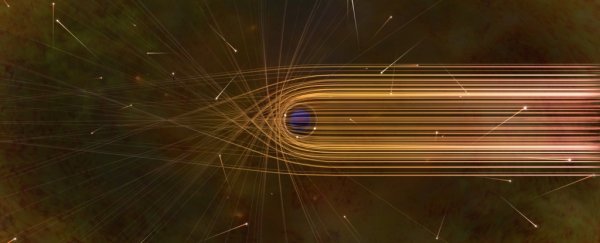A year ago, history was made. The long, painstaking work of scientists around the globe produced the very first direct image of the event horizon of a black hole, a supermassive monster called M87* 55 million light-years away. That glorious, golden, blurry image confirmed many of our ideas about black holes.
But the science didn't stop when the image came in. A team of scientists has now performed calculations based on what we learnt from M87* combined with the predictions of general relativity, to further predict how one day we could see this objects in much closer detail.
Black holes are incredibly gravitationally intense. Not only are they so massive that even light speed is too slow to achieve escape velocity against their gravitational pull, they also bend the path of passing light around them, beyond the event horizon.
If a passing photon is a bit too close, it will get trapped in orbit around the black hole. This creates what is called a "photon ring" or "photon sphere", a perfect ring of light predicted to surround the black hole, inside the inner rim of the accretion disc, but outside the event horizon.
This is also known as the innermost stable orbit, and you can see it in the below image, created by astrophysicist Jean-Pierre Luminet in 1978.
 (Jean-Pierre Luminet)
(Jean-Pierre Luminet)
Models of the black hole's surroundings suggest the photon ring should create an intricate substructure consisting of infinite rings of light - a bit like the effect you see in an infinity mirror.
"The image of a black hole actually contains a nested series of rings," explained astrophysicist Michael Johnson of the Harvard-Smithsonian Center for Astrophysics.
"Each successive ring has about the same diameter but becomes increasingly sharper because its light orbited the black hole more times before reaching the observer. With the current EHT image, we've caught just a glimpse of the full complexity that should emerge in the image of any black hole."
 (Event Horizon Telescope)
(Event Horizon Telescope)
In that historic first image of M87* (above), we can see the accretion disc - that's the glowing orange-gold part. The black part in the centre is the black hole's shadow. We can't actually see the photon sphere, since the ring is very fine, and the resolution isn't high enough to make it out, but it should sit around the edge of the black hole's shadow.
If we could see it, that ring would tell us very important things about the black hole. The size of the ring can tell us the mass, size and rotation of the black hole. We can determine these from the accretion disc, but the photon ring would allow us to constrain the data further, for a more precise measurement.
"Each subring consists of photons lensed toward the observer screen after having been collected by the photon shell from anywhere in the Universe," the researchers wrote in their paper.
"Hence, in an idealised setting with no absorption, each subring contains a separate, exponentially demagnified image of the entire Universe, with each subsequent subring capturing the visible Universe at an earlier time.
"Together, the set of subrings are akin to the frames of a movie, capturing the history of the visible Universe as seen from the black hole."
So, Johnson and his team used modelling to determine the feasibility of detecting the photon rings in future observations. They found that it can be done, although it won't be easy.
Imaging M87* was a feat of ingenuity and cooperation. Telescopes around the world worked together to create a very long baseline interferometer called the Event Horizon Telescope, where the precise distances and time differences between telescopes in the array can be calculated to stitch together their observations. It's - in very, very simple terms - like having a single Earth-sized telescope.
"What really surprised us was that while the nested subrings are almost imperceptible to the naked eye on images - even perfect images - they are strong and clear signals for arrays of telescopes called interferometers," Johnson said.
"While capturing black hole images normally requires many distributed telescopes, the subrings are perfect to study using only two telescopes that are very far apart. Adding one space telescope to the Event Horizon Telescope would be enough."
 (NASA/Xander89/Wikimedia Commons, CC BY 3.0)
(NASA/Xander89/Wikimedia Commons, CC BY 3.0)
Putting a telescope into low Earth orbit is a great start, but will only get us a clear shot of one of the rings.
To detect the second subring, you'd have to go a little farther than low-Earth orbit, putting a telescope on the Moon. And for the third, even farther still, out beyond the Moon in a stable position created by the Sun-Earth gravitational interaction called a Lagrange point, L2 in the diagram above.
None of these are unfeasible. NASA is planning a crewed mission to the Moon. And we already have a number of satellites sitting in L2. Obviously it wouldn't be happening tomorrow, but it is an exciting goal to work towards for the next generation of the Event Horizon Telescope.
The research has been published in Science Advances.
